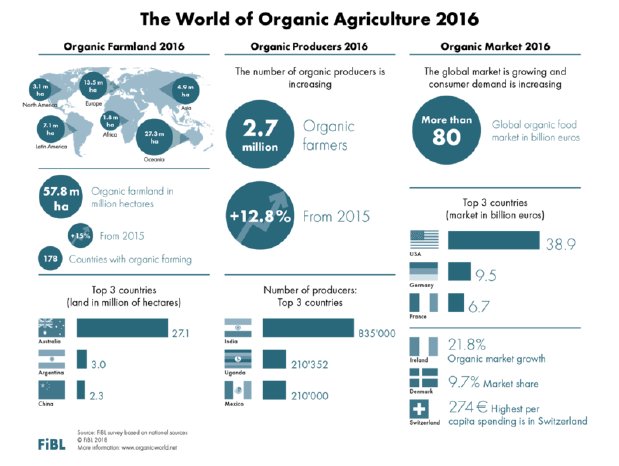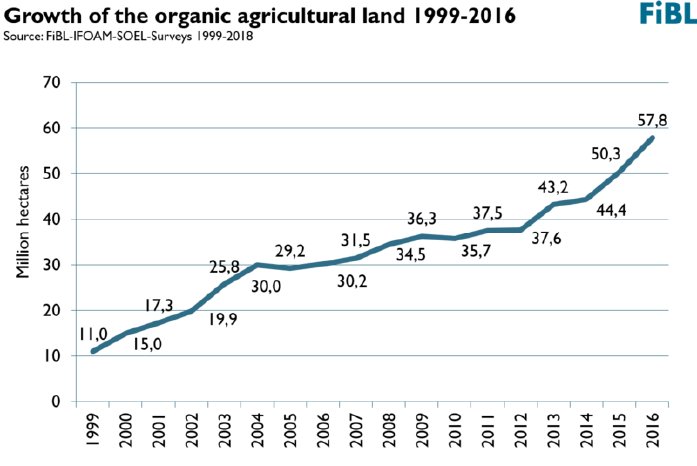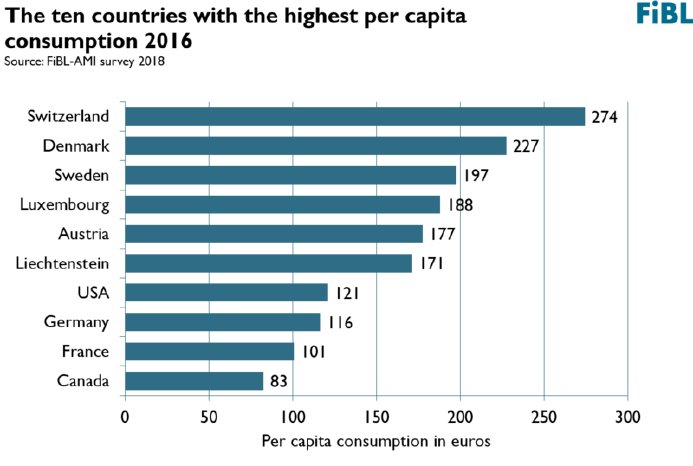The 2018 edition of the study “The World of Organic Agriculture” (data per end of 2016) published by FiBL and IFOAM – Organics International shows that the positive trend seen in the past years continues: Consumer demand for organic products is increasing, more farmers cultivate organically, more land is certified organic, and 178 countries report organic farming activities. The survey is supported by the Swiss State Secretariat for Economic Affairs (SECO), the International Trade Centre (ITC), and NürnbergMesse, the organizers of the BIOFACH fair.
The global organic market continues to grow
The market research company Ecovia Intelligence estimates that the global market for organic food reached 89.7 billion US dollars in 2016 (more than 80 billion euros). The United States is the leading market with 38.9 billion euros, followed by Germany (9.5 billion euros), France (6.7 billion euros), and China (5.9 billion euros). In 2016, most of the major markets continued to show double-digit growth rates, and the French organic market grew by 22 percent. The highest per capita spending was in Switzerland (274 Euros), and Denmark had the highest organic market share (9.7 percent of the total food market).
Almost three million producers worldwide
In 2016, 2.7 million organic producers were reported. India continues to be the country with the highest number of producers (835’200), followed by Uganda (210’352), and Mexico (210’000).
Organic farmland increases by 15 percent to almost 58 million hectares
A total of 57.8 million hectares were organically managed at the end of 2016, representing a growth of 7.5 million hectares over 2015, the largest growth ever recorded. Australia is the country with the largest organic agricultural area (27.2 million hectares), followed by Argentina (3 million hectares), and China (2.3 million hectares).
Almost haft of the global organic agricultural land is in Oceania (27.3 million hectares), followed by Europe (23 percent; 13.5 million hectares), and Latin America (12 percent; 7.1 million hectares).
Ten percent or more of the farmland is organic in fifteen countries
The countries with the largest organic share of agricultural land of their total farmland are the Liechtenstein (37.7 percent), French Polynesia (31.3 percent), and Samoa (22.4 percent). In fifteen countries, 10 percent or more of all agricultural land is organic, a new record.
Further information
Contacts
- Dr. Helga Willer, Communication, FiBL Switzerland
- Markus Arbenz, IFOAM – Organics International, Charles-de-Gaulle-Strasse 5, 53113 Bonn, Germany
Phone +49 (0)160 8041557, Fax +49 (0)228 9265099, m.arbenz(at)ifoam.bio, www.ifoam.bio
organic-world.net: "The World of Organic Agriculture" 2018 edition, graphs, and infographics
Online database
statistics.fibl.org: FiBL's new statistics website
On this website, tables with more details on organic land and crops, markets, and international trade, as well as explanations can be found.
Programme of the session "The World of Organic Agriculture – Statistics and Emerging Trends"
Wednesday, February 14, 2018, 4:00 to 4:45 pm, Hall Shanghai (NCC East), NürnbergMesse, Nuremberg
- Markus Arbenz, IFOAM – Organics International, Moderator
- Barbara Jäggin, SECO, Switzerland
- Dr. Helga Willer, FiBL: Latest data on organic agriculture worldwide
- Julia Lernoud, FiBL: Latest data on Voluntary Sustainability Standards worldwide
- Beate Huber, FiBL: Standards and regulations
- Amarjit Sahota, Ecovia Intelligence, UK: The global market for organic food
Supporters
- Swiss State Secretariat for Economic Affairs (SECO)
- International Trade Centre (ITC)
- NürnbergMesse, the organizers of the BIOFACH fair
Helga Willer and Julia Lernoud (Eds.) (2018): The World of Organic Agriculture. Statistics and Emerging Trends 2018. Research Institute of Organic Agriculture (FiBL), Frick and IFOAM – Organics International, Bonn. Available at www.organic-world.net/yearbook/yearbook-2018.html




